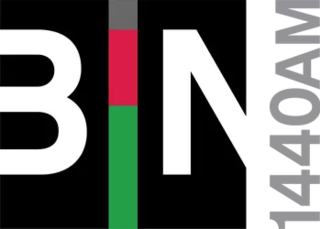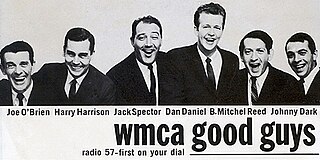Related Research Articles
Music radio is a radio format in which music is the main broadcast content. After television replaced old time radio's dramatic content, music formats became dominant in many countries. Radio drama and comedy continue, often on public radio.

Albert James "Alan" Freed was an American disc jockey. He also produced and promoted large traveling concerts with various acts, helping to spread the importance of rock and roll music throughout North America.

Rufus C. Thomas, Jr. was an American rhythm-and-blues, funk, soul and blues singer, songwriter, dancer, DJ and comic entertainer from Memphis, Tennessee. He recorded for several labels, including Chess Records and Sun Records in the 1950s, before becoming established in the 1960s and 1970s at Stax Records. He is best known for his novelty dance records, including "Walking the Dog" (1963), "Do the Funky Chicken" (1969), and "(Do the) Push and Pull" (1970). According to the Mississippi Blues Commission, "Rufus Thomas embodied the spirit of Memphis music perhaps more than any other artist, and from the early 1940s until his death . . . occupied many important roles in the local scene."

WLAC is a commercial radio station in Nashville, Tennessee. Owned by iHeartMedia, it broadcasts a talk radio format. The studios are in Nashville's Music Row district. It identifies itself as "TalkRadio 98.3 and 1510 WLAC" using the dial position of its FM translator at 98.3 MHz, as well as its AM frequency.
A radio format or programming format describes the overall content broadcast on a radio station. The radio format emerged mainly in the United States in the 1950s, at a time when radio was compelled to develop new and exclusive ways to programming by competition with television. The formula has since spread as a reference for commercial radio programming worldwide.
WERD was the first radio station owned and programmed by African Americans. The station was established in Atlanta, Georgia on October 3, 1949, broadcasting on 860 AM. The National Black Radio Hall of Fame Atlanta Chapter is reopening WERD which still exists at its birth location and will also include a historical museum with it after renovations of the facility are completed.
WTOB is an AM radio station licensed to Winston-Salem, North Carolina, United States, which serves the Piedmont Triad area. The station is currently owned by Richard Miller and Robert Scarborough, Ken Hauser and Richard Parker through licensee Southern Broadcast Media LLC. and airs a classic hits format.
WWRL is a commercial radio station licensed to New York City. WWRL airs an all-news radio format as an affiliate of the Black Information Network (BIN). The station is owned by iHeartMedia, Inc.
WDIA is a radio station based in Memphis, Tennessee. Active since 1947, it soon became the first radio station in the United States that was programmed entirely for African Americans. It featured black radio personalities; its success in building an audience attracted radio advertisers suddenly aware of a "new" market among black listeners. The station had a strong influence on music, hiring musicians early in their careers, and playing their music to an audience that reached through the Mississippi Delta to the Gulf Coast.

WGVL is a radio station licensed to Greenville, South Carolina. It is owned and operated by iHeartMedia, Inc. The station serves as Greenville's Black Information Network affiliate.
KWAM is a commercial radio station in Memphis, Tennessee, featuring a conservative talk radio format known as "The Mighty 990". Owned by Todd Starnes via Starnes Media Group, LLC, the stations serves the Memphis metropolitan area. KWAM's studios are located in Memphis, while the transmitter is in Marion, Arkansas. KWAM was founded in 1947 in West Memphis, Arkansas, as KWEM, helping "break" artists such as Elvis Presley, B.B. King, Johnny Cash, Ike Turner and Howlin' Wolf in the late 1940s and 1950s.
Douglas "Jocko" Henderson was an American radio disc jockey, businessman, and hip hop music pioneer.
WRAP was an historic black-oriented radio station in Norfolk, Virginia, on the air from 1952 to 1989. It served the Tidewater region, including Portsmouth, Newport News, Hampton and Virginia Beach. It began as one of only a handful of American radio stations broadcasting full-time to the African American community, featuring R&B, soul music and black gospel, along with news and talk programs.
GI Jive was a 15-minute radio program transmitted by the Armed Forces Radio Service for entertainment of soldiers in World War II. Its initial frequency of five days per week later increased to six days per week. It was included in the group of "programs proposed for production on the AFRS's initial schedule". GI Jive differed from AFRS programs like Command Performance and Mail Call in that it used a disc jockey format, with someone playing popular recordings of the day. In contrast, Command Performance and Mail Call broadcast live performances by popular entertainers.
Arthur Bernard Leaner, who was known professionally as Al Benson, was an American radio DJ, music promoter and record label owner in Chicago between the 1940s and 1960s. He was particularly significant for his promotion of rhythm and blues music and black involvement in the recording industry in Chicago.

The history of radio disc jockeys covers the time when gramophone records were first transmitted by experimental radio broadcasters to present day radio personalities who host shows featuring a variety of recorded music.
Joseph Deighton Gibson, Jr. was an American radio disc jockey and actor. He attended Lincoln University in Jefferson City, Missouri from 1940 to 1942, earning a bachelor's degree in science. He is regarded as the father of the Black appeal radio format.
Nathaniel Dowd Williams, known as Nat D. Williams or simply Nat D., was an American high school teacher, disc jockey on Black Appeal radio, journalist and editor. He was born on Beale Street in Memphis, Tennessee. Known for his ‘’jive’’ patter on the air, Williams had 10% of African-Americans in the U.S. listening to his program and heralded the changing radio style which helped to create "Black appeal radio", which it turn led to the urban contemporary listening format of Black radio in the 1960s and '70s.
Ed ‘Eddie’ Castleberry (1928–2009) was a pioneering newscaster, columnist and air personality at the Mutual Black Network, which produced 5-minute news spots that were broadcast on affiliated radio stations, MBN was later taken over by rival Sheridan Broadcasting Company in 1978 and by 1990 SBN had over 150 affiliates and grossed $15million annually.
The All-Negro Hour was an American broadcast show that was the first radio program to feature an exclusively African American cast of performers. This sixty-minute variety show was created and hosted by Jack L. Cooper who was known as the first African American radio broadcaster. The All-Negro Hour first premiered on November 3, 1929, on World Stage Battery Company (WSBC), a white-owned radio station in Chicago, and ran until 1935. The program aired on WSBC’s “ethnic appeal” station every Sunday night at 5 p.m. The “ethnic appeal” station was owned by Joseph Silverman, a battery manufacturer, who sold time on WSBC to individuals who were looking to appeal to a specific ethnic group. With the success starting from the program, The All-Negro Hour, Cooper is considered to be the creator of "black appeal", otherwise known as black radio.
References
- ↑ Barlow, William (1999) Voice Over: The Making of Black Radio- Philadelphia:Temple Univ press ISBN 1-56639-666-2, pg100
- ↑ Hilmes, M. (1997). Radio Voices: American Broadcasting, 1922-1952. Minneapolis: University of Minnesota Press, p. 272-3.
- ↑ Hilmes, M. (1997). Radio Voices: American Broadcasting, 1922-1952. Minneapolis: University of Minnesota Press, p. 273.
- ↑ Barnouw, Erik (1990). Tube of Plenty: The Evolution of American Television . New York: Oxford University Press. pp. 1–581.
- 1 2 Perry, Stephen (2004). A Consolidated History of Media. Bloomington, Illinois: Epistelogic Publishing. pp. 1–119.